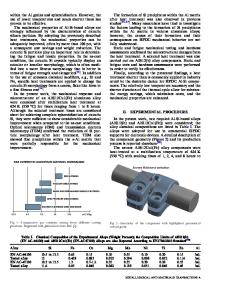Feeding of high-nickel alloy castings
- PDF / 815,634 Bytes
- 14 Pages / 612 x 792 pts (letter) Page_size
- 40 Downloads / 315 Views
I. INTRODUCTION
FEEDING distance (FD) in a casting is defined as the distance over which a riser can provide feed metal, resulting in a sound casting. This is an important concept for foundries, because the knowledge of FDs allows foundries to produce sound castings with a reasonable number of risers, which helps to maximize casting yield. Due to the importance of FDs, a great deal of effort has been expended to develop rules to determine riser FDs in steel castings. In 1973, the Steel Founders’ Society of America (SFSA) published a foundry handbook entitled Risering Steel Castings;[1] this handbook provided charts, nomographs, and equations for calculating FDs for carbon and low-alloy (C&LA) and several high-alloy steels. While the feeding guidelines in this handbook have been widely used in industry for the past 30 years, it is generally accepted that these rules can be overly conservative in many situations. To address the need for more accurate, less conservative feeding rules, the authors of the present study developed a new set of C&LA FD rules,[2,3,4] followed by an analogous set of rules for high-alloy steel grades CF-8M, CA-15, HH, HK, and HP.[5] Both sets of rules were developed by performing both plate-casting trials and corresponding casting simulations of these trials. Through this work, a correlation was developed between the Niyama criterion (a local thermal parameter) and radiographic soundness. It was found that the same correlation was valid for both C&LA and high-alloy steels. Once this correlation was established, a large number of simulations were performed in order to determine FDs for a wide variety of casting conditions. Based on the resulting information, a new set of FD rules was developed. These rules are designed to produce radiographically sound castings at 2 pct sensitivity. Rules are provided for both end-effect and lateral FDs for top KENT D. CARLSON, Assistant Research Engineer, SHOUZHU OU, Postdoctoral Research Associate, and CHRISTOPH BECKERMANN, Professor, are with the Department of Mechanical and Industrial Engineering, The University of Iowa, Iowa City, IA 52242. Contact e-mail: becker@ engineering.uiowa.edu Manuscript submitted May 17, 2005. METALLURGICAL AND MATERIALS TRANSACTIONS B
risers, as well as the FD for side risers. In addition, multipliers are provided to apply these rules with end chills and drag chills, as well as to tailor these rules to different alloy compositions (both C&LA and high-alloy steels), sand mold materials, and pouring superheats. These new rules are shown to provide longer FDs in most casting situations than do the previously published rules. The objective of the present study is to develop new FD rules for four additional alloys: three nickel-based alloys (CW12MW, CZ-100, and Monel-35-1) and an austenitic stainless steel (CN-7M) with a large nickel content. In the study, they are collectively referred to as high-nickel alloys. The nominal compositions for each of these alloys are provided in Table I. No published feeding rules are presently avai
Data Loading...











